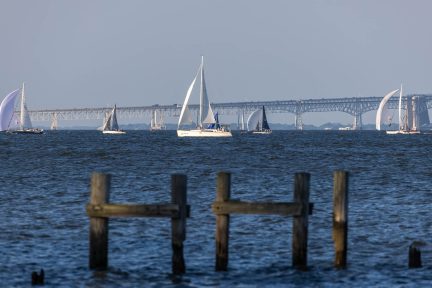Rise in Chesapeake Bay underwater grasses for fourth year in a row
In 2016, an estimated 97,433 acres of underwater grasses were mapped in the Chesapeake Bay: the highest amount ever recorded by the Virginia Institute of Marine Science.
In 2016, an estimated 97,433 acres of underwater grasses were mapped in the Chesapeake Bay: the highest amount ever recorded by the Virginia Institute of Marine Science (VIMS).
This total is 7,433 acres greater than the Chesapeake Bay Program’s 2017 restoration target and 53 percent of the 185,000-acre 2025 goal adopted in the Chesapeake Bay Watershed Agreement. Moreover, it is likely that more submerged aquatic vegetation (SAV) grew in the region than this estimate suggests: weather conditions and security restrictions prevented researchers from collecting aerial imagery over a portion of the Potomac River. This portion of the Potomac supported almost 2,000 acres of grasses in 2015, and trends suggest this area would have put the Bay-wide total at 99,409 acres—or 54 percent of the goal—had it been mapped.
Experts attribute this rise in underwater grass abundance to a strong increase in the tidal freshwater and moderately salty regions of the Bay. Widgeon grass, in particular, expanded in the latter region, but because it is a “boom and bust” species whose abundance can rise and fall from year to year, a widgeon-dominant spike is not guaranteed to persist in future seasons.
In addition to its annual financial support of the aerial surveys that are used to monitor underwater grasses across the region, the Chesapeake Bay Program has funded a citizen science project in which local riverkeepers, watershed organizations and volunteers will collect data on underwater grass abundance and species diversity during the 2017 growing season. As part of this project, Chesapeake Commons is expanding its Water Reporter app to include bay grass monitoring features. By downloading the app and joining the Chesapeake Bay SAV Watchers group, anyone with a smartphone can help monitor underwater grasses whenever and wherever they are on the water.
Underwater grass abundance can vary from species to species and river to river. In 2016, local highlights included:
- The Susquehanna Flats. The iconic grass beds at the mouth of the Susquehanna River provide critical habitat to fish and shellfish, and food to migrating waterfowl. In 2011, Hurricane Irene and Tropical Storm Lee reduced underwater grass abundance in the Susquehanna Flats by more than one-third, from 13,273 acres to 8,479 acres. These grass beds fell to 6,024 acres in 2012 before they began to expand again in 2013. Over the past four years, grasses in the region have steadily recovered. In 2016, the beds reached 8,617 acres, with the biggest bed in the system reaching 5,993 acres. Researchers observed more than 11 grass species growing there, including wild celery, water stargrass, coontail and several naiads and pondweeds. Species diversity is critical to bed resilience and habitat quality.
- Smith and Tangier Islands. At over 10,000 acres, the grasses that stretch from Smith Island to Tangier Island make up the biggest contiguous grass bed in the Bay. Widgeon grass dominates the area, but eelgrass can also be found. Large grass beds like this one are more resilient than smaller, fringe beds, which are more susceptible to stressors like limited light or direct physical damage.
- The Chester River. Between 2015 and 2016, there was a threefold increase in underwater grasses in the middle and upper portions of the Chester River, from 108 to 460 acres. Wild celery dominates the grass beds, and local efforts by the Maryland Department of Natural Resources and Anne Arundel Community College to restore wild celery from seed have shown promising success.
Facts
Between 2015 and 2016, underwater grass abundance in the regions of the Chesapeake Bay that were mapped in both years increased eight percent from 90,334 acres to 97,427 acres. Underwater grass abundance across the entire Bay measured 92,315 acres in 2015, and conservative estimates for the areas of the Bay that were not mapped suggest this number would have been at least 99,409 acres in 2016. This total surpasses the Chesapeake Bay Program’s 2017 restoration target and marks a 54 percent achievement of the partnership’s 2025 185,000-acre goal.
In 2016, four Maryland rivers surpassed their underwater grass restoration goals: the North East, the Middle, the Honga and Fishing Bay. Six Maryland rivers, four Virginia rivers and two District of Columbia rivers had segments that surpassed their restoration goals: the Big Annemessex, Chester, Elk, Gunpowder, Manokin and Chesapeake & Delaware Canal in Maryland; the James, Pamunkey, Upper and Middle Potomac, and Rappahannock in Virginia; and the Anacostia and Upper Potomac River in Washington, D.C.
Tracking Bay Grass Abundance by Salinity Zone:
Between 2015 and 2016:
- Bay grass abundance in the Bay’s fresh waters (the Tidal Fresh Salinity Zone) fell 158 acres (from 17,477 acres to 17,319 acres), achieving 84 percent of the zone goal. However, researchers were not able to collect aerial imagery over a portion of this zone. A comparison between the regions of the zone that were mapped in both 2015 and 2016 shows bay grass abundance rose 1,430 acres.
- Bay grass abundance in the Bay’s slightly salty waters (the Oligohaline Salinity Zone) fell 1,606 acres (from 10,109 acres to 8,503 acres), achieving 82 percent of the zone goal.
- Bay grass abundance in the Bay’s moderately salty waters (the Mesohaline Salinity Zone) rose 9,324 acres (from 48,062 acres to 57,386 acres), achieving 48 percent of the zone goal. However, researchers were not able to collect aerial imagery over a portion of this zone. A comparison between the regions of the zone that were mapped in both 2015 and 2016 shows bay grass abundance rose 9,712 acres.
- Bay grass abundance in the Bay’s very salty waters (the Polyhaline Salinity Zone) fell 2,441 acres (from 16,667 acres to 14,226 acres), achieving 42 percent of the zone goal.
Issues
Like grasses on land, underwater grasses need sunlight to survive. When the waters of the Chesapeake Bay become clouded with algae blooms or suspended sediment, sunlight cannot reach the bottom habitat where these grasses grow. While healthy grass beds can trap and absorb some nutrient and sediment pollution—thus improving water clarity where they grow—too much pollution can cause grass beds to die off. Water temperatures, strong storms and drought can also affect the growth and survival of underwater plants. Chesapeake Bay Program partners are working to improve water clarity, protect and restore grass beds, enhance bay grass research and expand education and outreach to restore underwater grasses and boost their habitat benefits in the watershed.
Importance
Underwater grass beds are critical to the Chesapeake Bay ecosystem. They keep our waters clean by absorbing excess nutrients, trapping suspended sediment and slowing wave action and shoreline erosion. Bay grasses also offer food to small invertebrates and migratory waterfowl and shelter young fish and blue crabs. In fact, bay grass abundance is one of several factors that can impact the health and stability of the blue crab population: the loss of these grasses is a loss of nursery habitat, which pushes young crabs to gather in the limited nurseries that remain.
Earlier this month, data collected by Maryland and Virginia through the Bay-wide Blue Crab Winter Dredge Survey showed that, while the overall blue crab population fell 18 percent between 2016 and 2017, the abundance of adult females increased 31 percent from 194 million to 254 million. The Chesapeake Bay Program tracks the abundance of adult female blue crabs in relation to a population target and an overfishing threshold as an indicator of blue crab population health. The 2017 total is above the 70 million threshold and the 215 million target and marks the highest amount ever recorded by the Winter Dredge Survey.
Because bay grasses are sensitive to pollution but quick to respond to water quality improvements, their abundance is a good indicator of Bay health. To support the resurgence of underwater grass beds in the Bay, cities and towns can reduce polluted runoff and upgrade wastewater treatment plants with pollution-reducing technologies, farmers can use best management practices to keep fertilizers in their fields, boaters can steer clear of bay grass beds that are growing in shallow waters and homeowners can use rain barrels or rain gardens to slow nutrient- and sediment-laden stormwater runoff.
Quotes
“The report on expansion of underwater grasses throughout the Chesapeake further supports our assessment that we have reached a tipping point for numerous indicators that we use to determine the health of the watershed. The ecosystem is responding to the pollution control and restoration measures that the partners have implemented – controlling discharges from wastewater treatment plants, stormwater and agricultural runoff. These investments are showing their return in terms of environmental improvement throughout the watershed. What we are doing is working. We just need to do more of it.”
-- Nick DiPasquale, Director, Chesapeake Bay Program and Chair, Chesapeake Bay Program Management Board
“As a bay grass biologist, it is thrilling to see SAV recovering in the Chesapeake. Bay grasses exceeded our 2017 midterm goal of 90,000 acres for the second year, with reports of recovering SAV species diversity in many areas as well. With continuing commitments to further reduce pollutants entering the Bay’s waters, I believe it’s possible to reach records every year and foster thriving SAV beds throughout the Bay–SAV beds that will promote ecological resilience and provide economic and recreational opportunities for generations to come.”
--Brooke Landry, Natural Resources Biologist, Maryland Department of Natural Resources and Chair, Chesapeake Bay Program’s Submerged Aquatic Vegetation Workgroup
“Having watched the ebb and flow of SAV over the last 32 years of monitoring, it is heartening to see this continued expansion, especially in the tidal fresh water and mid-salinity portions of the Bay. We are cautiously optimistic that we may actually see well over 100,000 acres of SAV in 2017, with the Chesapeake Bay Total Maximum Day Load finally kicking in and having an influence in the Bay.”
--Bob Orth, Director of SAV Aerial Survey, Virginia Institute of Marine Science



